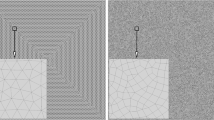Abstract
A numerical method for flows of heterogeneous two-phase compressible media is considered. The main problem in the construction of such a method is to find the interface between the components with different physical and mechanical properties. An efficient method for solving this problem that gives a good spatial resolution of the interfaces is proposed. This method is based on the use of the Cahn–Hilliard equation. To describe the flow of the two-phase medium, the single-velocity five-equation model is used; in this model, the Cahn–Hilliard equation is used as the equation for the order function. This makes it possible to significantly decrease the domain of the interface numerical smearing. Numerical results confirm the high accuracy and effectiveness of the proposed method.





Similar content being viewed by others
REFERENCES
C. W. Hirt, A. A. Amsden, and J. L. Cook, “An arbitrary Lagrangian–Eulerian computing method for all flow speeds,” J. Comput. Phys. 14, 227–253 (1974).
M. Sussman, P. Smereka, and S. Osher, “A level set approach for computing solutions to incompressible two-phase flow,” SIAM J. Sci. Comput. 29, 1781–1824 (2007).
J. Glimm, X. L. Li, Y. J. Liu, Z. L. Xu, and N. Zhao, “Conservative front tracking with improved accuracy,” SIAM J. Numer. Anal. 41, 1926–1947 (2003).
H. Terashima and G. Tryggvason, “A front-tracking/ghost-fluid method for fluid interfaces in compressible flows,” J. Comput. Phys. 228, 4012–4037 (2009).
W. Mulder, S. Osher, and J. A. Sethian, “Computing interface motion in compressible gas dynamics,” J. Comput. Phys. 100, 209–228 (1992).
R. Abgrall, “How to prevent pressure oscillations in multicomponent flow calculations: A quasi-conservative approach,” J. Comput. Phys. 125, 150–160 (1996).
R. Saurel and R. Abgrall, “A multiphase Godunov method for compressible multi-fluid and multiphase flows,” J. Comput. Phys. 150, 425–467 (1999).
I. Menshov and P. Zakharov, “On the composite Riemann problem for multi-material fluid flows,” Int. J. Numer. Meth. Fluids 76, 109–127 (2014).
G. Allaire, S. Clerc, and S. Kokh, “A five-equation model for the simulation of interfaces between compressible fluids, J. Comput. Phys. 181, 577–616 (2002).
A. Tiwari, B. F. Jonathan, and C. Pantano, “A diffuse interface model with immiscibility preservation,” J. Comput. Phys. 252, 290–309 (2013).
A. K. Kapila, R. Menikoff, J. B. Bdzil, S. F. Son, and D. S. Stewart, “Two-phase modeling of deflagration-to-detonation transition in granular materials: Reduced equations,” Phys. Fluids 13, 3002–3024 (2001).
V. A. Balashov and E. B. Savenkov, “A quasi-hydrodynamic system of equations for describing flows of multiphase fluid taking into account surface effects,” Preprint of the Keldysh Institute of Applied Mathematics, Russ. Acad. Sci., Moscow, 2015, no. 75, p. 37.
V. A. Balashov and E. B. Savenkov, “Quasi-hydrodynamic model of multiphase fluid flows taking into account phase interaction,” J. Appl. Mech. Tech. Phys. 59, 434–444 (2018).
J. W. Cahn and J. E. Hilliard, “Free energy of a nonuniform system. I. Interfacial free energy,” J. Chem. Phys. 28, 258–267 (1958).
M. E. Gurtin, “Generalized Ginzburg–Landau and Cahn–Hilliard equations based on a microforce balance,” Phys. Fluids 92, 178–192 (1996).
M. I. M. Copetti and C. M. Elliott, “Numerical analysis of the Cahn–Hilliard equation with a logarithmic free energy,” Numer. Math. 63, 39–65 (1992).
B. N. Chetverushkin, “Kinetically consistent schemes in gas dynamics,” Mat. Model. 11 (5), 84–100 (1999).
T. G. Elizarova, M. E. Sokolova, and Yu. V. Sheretov, “Quasi-gasdynamic equations and numerical modeling of the viscous gas flows,” Comput. Math. Math. Phys. 45, 524–534 (2005).
S. K. Godunov, “A difference scheme for numerical solution of discontinuous solution of hydrodynamic equations,” Mat. Sb. 47 (89), 271–306 (1959).
E. F. Toro, Riemann Solvers and Numerical Methods for Fluid Dynamics, 3rd ed. (Springer, 2009).
V. Coralic and T. Colonius, “Finite-volume WENO scheme for viscous compressible multicomponent flows,” J. Comput. Phys. 274, 95–121 (2014).
N. Franchina, M. Savini, and F. Bassi, “Multicomponent gas flow computations by a discontinuous Galerkin scheme using L2-projection of perfect gas EOS,” J. Comput. Phys. 315, 302–322 (2016).
ACKNOWLEDGMENTS
We are grateful to the reviewer for useful remarks.
Funding
This work was performed within the state assignment of the Scientific Research Institute for System Analysis of the Russian Academy of Sciences (basic scientific research GP 14), subject no. 0065-2019-0005 (project no. АААА-А19-119011590092-6) and was supported by the Russian Foundation for Basic Research (project no. 18-01-00921a).
Author information
Authors and Affiliations
Corresponding authors
Additional information
Translated by A. Klimontovich
Rights and permissions
About this article
Cite this article
Menshov, I.S., Zhang, C. Interface Capturing Method Based on the Cahn–Hilliard Equation for Two-Phase Flows. Comput. Math. and Math. Phys. 60, 472–483 (2020). https://doi.org/10.1134/S0965542520030124
Received:
Revised:
Accepted:
Published:
Issue Date:
DOI: https://doi.org/10.1134/S0965542520030124




